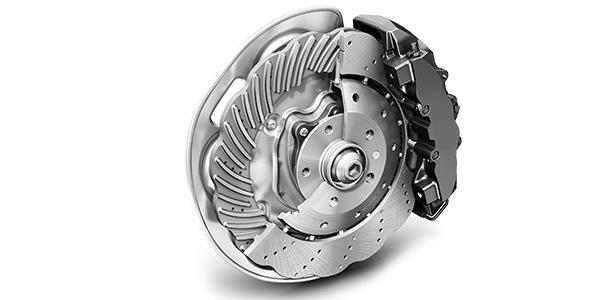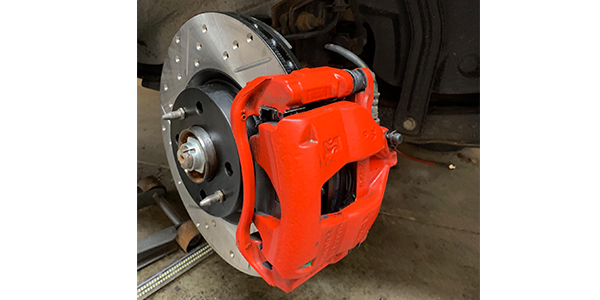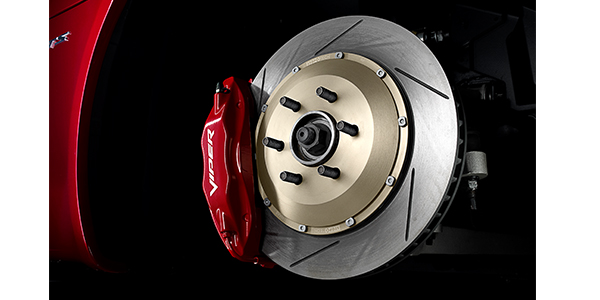
Over the past decade, there has been an impressive intellectual property crime happening in the world of brakes. Instead of knocking off the latest movie, app or gadget, some Chinese companies have been creating caliper covers that make an ordinary single- or dual-piston floating caliper look like a six- or eight-piston racing caliper. While it is one of the most laughable modifications an owner can perform, it does demonstrate that there is demand for performance brake upgrades or at least brake components that have a high-performance appearance.
Is this an opportunity in the shop? Yes.
In my opinion, this passion for the appearance of the brake system can be a way to actually elevate the importance of brake system performance, while giving you a new sales opportunity, and a way to differentiate brake service offerings from other shops.
Knowing Your Customer
The first question to ask yourself and the customer is what does brake performance mean and how does it apply to their vehicle? A driver’s expectations can vary depending on their experience and how much propaganda they have absorbed. If you get to know the customer, you will find out if he or she is more concerned with appearance, performance, or both. This is not necessarily just for race cars or hot rods. For some customers, it might mean better brake performance while towing or enhancing a set of wheels.

There are three questions to ask a customer about what is most important from any brake system upgrade:
- “Are you experiencing any current issues with your brakes?” This question can help to address any problems with the current system like a low pedal or longer-than-normal braking distances.
- “What do you expect from the upgrade?” If the customer thinks a set of pads or rotors will instantly give their vehicle supercar-like brakes, they will be disappointed. This question is a chance to find out if they are looking for a stiffer brake pedal, decreased stopping distances or just a better-looking brake package.
- “How do you use the vehicle?” Drag, road and autocross racing each put different demands on the brake system and require different performance attributes. Even if the customer does not race, frequent stop and go traffic as well as frequent towing can make better brakes a valuable improvement.
What is Performance?
If you ask any engineer, you’ll find that it is tougher to engineer a brake system for the street than the track. On the track, the key is to stop – now. With street brakes, noise, efficiency and developing enough stopping force for specific situations dictated by federal standards must be considered.
The primary function of any brake system is to convert forward kinetic energy into heat energy using friction. How friction levels and heat are managed is what sets a high-performance brake system apart from a stock system.
When the OEMs are engineering a brake system, there are specific Federal Motor Vehicle Safety Standards (FMVSS) testing procedures for brake systems. The most demanding test for brakes involves a V-max test that consists of accelerating to a vehicle’s top speed (V-max) and stopping within a specified distance. The other stressful FMVSS requires performing ten successive stops from 30 mph. Both tests involve measuring the temperature of the brake pads.
High-performance “street” brake systems need to meet the same requirements and even exceed these test parameters.
Racing brake systems can vary due to the different types of racing environment. Drag racers need to perform a single stop from high speed with cold brakes. Circle track cars might have to make two stops a lap for 20 laps or more. Road racing cars might have to use the brakes 7-20 times during a lap.
These different performance requirements on both street and racing vehicles dictate the size of the rotor, caliper design, and formulation of the friction material. However, the limiting factor for all brakes are the tires. You could install rotors the size of garbage can lids and brake pads with the highest level of friction, but if the tires don’t have traction, the wheels will lock, causing the driver to lose control.
Almost every high-performance brake component improves the looks of the brakes on a vehicle. These cosmetic improvements are essential because late model cars and trucks are no longer using stamped steel wheels and the brakes can be seen through the spokes of the wheels.
Friction Materials
When NHRA Top Fuel classes switched to carbon fiber brakes in the early 2000s, there were several crashes attributed to the drivers not having experience with the new pads and rotors. Drivers were familiar with cast iron brakes and their ability to generate friction when the pedal was first applied.
Carbon fiber brakes reduced the rotating mass and were less susceptible to catastrophic failure due to heat shock. But, carbon fiber brakes did not start generating significant friction levels until they got hot. Many drivers panicked when they first applied the brakes and assumed it was a hydraulic failure and started to pump them rapidly in the shutdown area.
The same phenomenon can happen to street driven vehicles if the brake pads are replaced with a “race only” or overly aggressive friction material that needs heat to work. A lot of street performance pads can balance friction levels, meaning the driver is not caught off guard by cold brakes.

When most people think performance brakes, they automatically think semi-metallic brake pads. Semi-metallic friction materials use metal fibers to give structure and provide friction. The metals used are typically steel, copper, and other metals. Semi-met friction materials use the abrasive qualities of the metals in the pad and the rotor to generate friction. On an atomic level, the atoms and molecules of the pad and rotor are ripping their bond to create heat and friction of mechanical forces are applied. This phenomenon causes wear to the rotor and brake pad at different rates.
In some street applications, a performance pad with a non-asbestos organic or ceramic formulation might be the best choice for a customer’s daily driver where the cosmetic appearance of the brakes might be more important than late braking performance. These friction materials use adherent (adhesive) friction, in which the pad seasons or transfers a layer of material to the rotor. As the brakes are applied, the pads replenish the transfer layer. The layer can reduce rotor wear and even minimize brake dust if the driver is concerned about brake dust.
Rotors
A brake rotor absorbs and dissipates the heat energy generated by friction. How well the rotor can absorb and then release it into the surrounding air will determine the efficiency and capacity of the brakes.
The design of the rotor determines how it can handle the heat. On vented rotors, the thickness of the plates and how well air flows through the vanes helps to transfer heat to the surrounding air. Curved vane designs on some vented rotors help to pull air through the center of the rotor to the outer edge and act as a pump. For curved vanes to work, they must be mounted on the hub in the correct direction, just as a directional tire must be mounted on the right wheel.
Slots cut into the face of the rotor have two functions. First, they provide leading edges for a better initial bite from the pad. Second, each groove provides a path for the gases being released by the pad. If the slots fill up with pad material, the brakes system is operating at too high a temperature. Slots are radiused when milled to prevent stress in the rotor. Most slotted rotor manufacturers will not cut the slot to the edges of the rotor; doing so will compromise the strength of the rotor.
Holes drilled in the rotor can provide another path for the gases to escape from the pads and help with the initial bite of the pad. In some cases, the holes can reduce the weight of the rotor and improve cooling as well. But there is a science to the holes, so the structure or the rotor is not compromised. Too many holes or holes near vanes can cause cracks. Also, the hole should have a chamfer to avoid creating a stress riser that can cause a crack.
The size of the brake rotor determines the rotor’s ability to generate brake force or torque. The best analogy is to try to turn a steering wheel using an inner spoke and then again using the outer wheel portion. The further you move your hand out, the easier it is to turn the wheel.
Two-piece rotors included on some cars and in “big brake” kits have two advantages. First, two-piece rotors reduce rotational and unsprung mass. Second, the hat that is made of aluminum acts as a heat dam to prevent heat from being transferred to the hub, bearings, and knuckle.
The most significant trend in rotors is using slots, holes and finishes on the hat and vanes to improve the cosmetics of the brake system.

Calipers
For any brake pad to be 100% effective on the street or track, the caliper must be able to translate the hydraulic force evenly to the pads. To do this, the caliper must be able to float on the slides/brackets and/or the pistons must move freely in the bores.
Performance fixed calipers with four, six, or even eight pistons improve the braking performance by increasing the effective area of the brake pads. With more pistons, the hydraulic pressure from the master cylinder can be evenly distributed to the backing plate and friction material.
New calipers can also improve the cosmetics of the brake system. Many lines of premium brake calipers include high-quality coating, plating processes and finishes on the caliper, so it looks great behind the wheel.
Trends
Recently, we have seen a lot of companies entering the performance replacement market with kits that include drilled and/or slotted rotors packaged with brake pads for one or both axles. These kits are typically available online and rarely stocked by the traditional distribution chain.
Another option is to build your own brake kit. Many brake suppliers have lines of high-performance rotors and pads. You can pick and choose the right rotor and pad combination to suit the customer. For a customer that wants the appearance of a racing brake system but low maintenance, you can select a drilled and slotted rotor and then select a ceramic friction formulation to reduce noise and brake dust.
Some of these kits and components are the real deal and can improve not only the performance but the cosmetics of the brakes behind the wheels. Unfortunately, some kits are not – they’re really nothing more than the same old low-quality rotors and pads but with holes and slots in the rotor. Drilling and slotting a low-quality rotor will not change the metallurgy or configuration of the vanes. Do your homework.
Article courtesy Brake & Front End.













